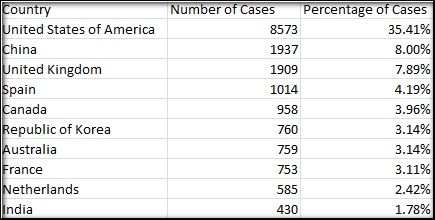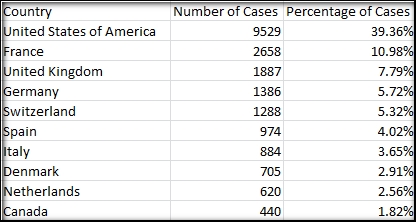Where do cybersquatters live?
The World Intellectual Property Organization has published interesting statistics - the location data of respondents for complaints of illegal domain seizure according to the UDRP procedure, i.e. accused of cybersquatting.
Of course, these data do not claim to be completely objective. Firstly, not all complaints about cybersquatting are satisfied (although most are). Secondly, cybersquatters may provide false information about themselves. Thirdly, it is not known whether complaints about domain seizure in national domain zones were included in the statistics and how many were such complaints. Finally, not all cybersquatters receive complaints. For most companies, contacting WIPO is a last resort. However, the information received is very curious.
Most cybersquatters in the USA and China.

For comparison, statistics on the location of plaintiffs who complained about cybersquatters.

We also note that, according to WIPO, the scale of cybersquatting for the first half of this year increased by 11% compared with the second half of 2011 (WIPO received 1764 and 1584 complaints during these time periods, respectively.)
But these statistics, again, are inaccurate. In addition to the factors mentioned above, it does not take into account the increase in the number of registered domains. If we correlate the number of domains and the number of complaints about cybersquatting, it turns out that the scale of cybersquatting, on the contrary, is decreasing. The fact that several domains can be indicated in one cybersquatting complaint at the same time was not taken into account in the calculation. The statistics are also greatly influenced by the activities of large firms such as Lego or Google, which can submit several tens or even hundreds of complaints.
Of course, these data do not claim to be completely objective. Firstly, not all complaints about cybersquatting are satisfied (although most are). Secondly, cybersquatters may provide false information about themselves. Thirdly, it is not known whether complaints about domain seizure in national domain zones were included in the statistics and how many were such complaints. Finally, not all cybersquatters receive complaints. For most companies, contacting WIPO is a last resort. However, the information received is very curious.
Most cybersquatters in the USA and China.

For comparison, statistics on the location of plaintiffs who complained about cybersquatters.

We also note that, according to WIPO, the scale of cybersquatting for the first half of this year increased by 11% compared with the second half of 2011 (WIPO received 1764 and 1584 complaints during these time periods, respectively.)
But these statistics, again, are inaccurate. In addition to the factors mentioned above, it does not take into account the increase in the number of registered domains. If we correlate the number of domains and the number of complaints about cybersquatting, it turns out that the scale of cybersquatting, on the contrary, is decreasing. The fact that several domains can be indicated in one cybersquatting complaint at the same time was not taken into account in the calculation. The statistics are also greatly influenced by the activities of large firms such as Lego or Google, which can submit several tens or even hundreds of complaints.
